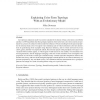Free Online Productivity Tools
i2Speak
i2Symbol
i2OCR
iTex2Img
iWeb2Print
iWeb2Shot
i2Type
iPdf2Split
iPdf2Merge
i2Bopomofo
i2Arabic
i2Style
i2Image
i2PDF
iLatex2Rtf
Sci2ools
COGSCI
2007
2007
Explaining Color Term Typology With an Evolutionary Model
An expression-induction model was used to simulate the evolution of basic color terms to test Berlin and Kay’s (1969) hypothesis that the typological patterns observed in basic color term systems are produced by a process of cultural evolution under the influence of biases resulting from the special properties of universal focal colors. Ten agents were simulated, each of which could learn color term denotations by generalizing from examples using Bayesian inference, and for which universal focal red, yellow, green, and blue were especially salient, but unevenly spaced in the perceptual color space. Conversations between these agents, in which agents would learn from one another, were simulated over several generations, and the languages emerging at the end of each simulation were investigated. The proportion of color terms of each type correlated closely with the equivalent frequencies found in the World Color Survey, and most of the emergent languages could be placed on one of the ...
| Added | 12 Dec 2010 |
| Updated | 12 Dec 2010 |
| Type | Journal |
| Year | 2007 |
| Where | COGSCI |
| Authors | Mike Dowman |
Comments (0)

